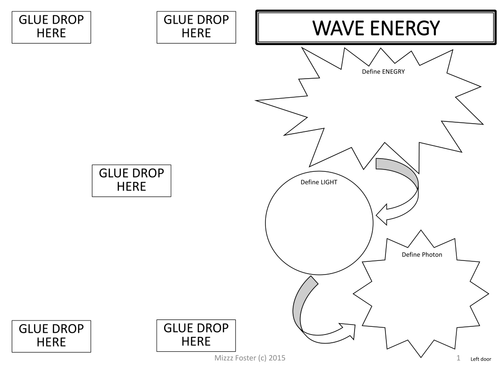








Electromagnetic Spectrum and Energy Power Point
The power point covers the electromagnetic spectrum, light, photons, waves and their characteristics. the relationship between frequency, wavelength, and the speed of light are introduced with the formula for speed of light.
Calculating the energy of the electromagnetic waves is also covered with introduction to Planck's constant and the energy formula derived using the constant. How we see light is presented along with slides for each type of electromagnetic ray and how they can affect human health. I also have a slide on cosmic rays since they have the most energy of all electromagnetic rays.
Electromagnetic Spectrum Graphic Organizer (with energy and light formulas)
The fold-out foldable covers the electromagnetic spectrum, light, photons, waves and their characteristics. The relationship between frequency, wavelength, and the speed of light are introduced with the formula for speed of light.
Calculating the energy of the electromagnetic waves is also covered with introduction to Planck's constant and the energy formula derived using the constant.
Electromagnetic Spectrum: Eight Types of Waves 1 pg Foldable
This one page foldable has eight flaps for a description of radio waves, microwaves, infrared, visible light, ultraviolet, x-rays, gamma and cosmic rays. There are illustrations, instructions and a key included.
Visible Light Spectrum: Speed of Light, Planck's Constant, Energy of Light
In this worksheet students will use a visible light spectrum chart to calculate the wavelength of different colors of light. Then using the light equation and speed of light the students will figure out the frequency for each color. In the next step, students will use the frequency and Planck's constant in order to calculate the energy each color of light carries.
Students will also need to color the spectrum. I have mine work out their calculations on a separate sheet of notebook paper and turn it in attached to their charts. I have included an answer sheet so you can see what the final should look like. For my younger students I give them the color wavelengths. For my physics students I have them use the chart and figure the wavelengths out on their own. I use this in both Chemistry and Physics.
The power point covers the electromagnetic spectrum, light, photons, waves and their characteristics. the relationship between frequency, wavelength, and the speed of light are introduced with the formula for speed of light.
Calculating the energy of the electromagnetic waves is also covered with introduction to Planck's constant and the energy formula derived using the constant. How we see light is presented along with slides for each type of electromagnetic ray and how they can affect human health. I also have a slide on cosmic rays since they have the most energy of all electromagnetic rays.
Electromagnetic Spectrum Graphic Organizer (with energy and light formulas)
The fold-out foldable covers the electromagnetic spectrum, light, photons, waves and their characteristics. The relationship between frequency, wavelength, and the speed of light are introduced with the formula for speed of light.
Calculating the energy of the electromagnetic waves is also covered with introduction to Planck's constant and the energy formula derived using the constant.
Electromagnetic Spectrum: Eight Types of Waves 1 pg Foldable
This one page foldable has eight flaps for a description of radio waves, microwaves, infrared, visible light, ultraviolet, x-rays, gamma and cosmic rays. There are illustrations, instructions and a key included.
Visible Light Spectrum: Speed of Light, Planck's Constant, Energy of Light
In this worksheet students will use a visible light spectrum chart to calculate the wavelength of different colors of light. Then using the light equation and speed of light the students will figure out the frequency for each color. In the next step, students will use the frequency and Planck's constant in order to calculate the energy each color of light carries.
Students will also need to color the spectrum. I have mine work out their calculations on a separate sheet of notebook paper and turn it in attached to their charts. I have included an answer sheet so you can see what the final should look like. For my younger students I give them the color wavelengths. For my physics students I have them use the chart and figure the wavelengths out on their own. I use this in both Chemistry and Physics.
Something went wrong, please try again later.
This resource hasn't been reviewed yet
To ensure quality for our reviews, only customers who have purchased this resource can review it
Report this resourceto let us know if it violates our terms and conditions.
Our customer service team will review your report and will be in touch.
£7.00
